Configure how absences are tracked, reasons for absences, and who is required to approve absences
Article Content
This article covers the following topics. Click on the topic to go to that section of the article.
To begin, click on Admin> Manage Absences. The left sidebar will display the administrative options. Click on Settings to begin configuration.
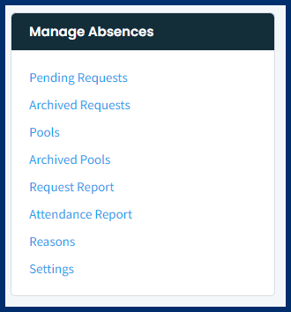
- Pending Requests: Displays any pending learner requests that require approval.
-
Archived Requests: Stores requests that have been approved or rejected. Staff: admin have the ability to make changes to archived requests.
-
Pools: This is where you can configure timeframes and groups for tracking absences. For example, if your attendance policy requires that absences be tracked by event type you could make a pool per cohort for each event type.
-
Please be aware that when multiple pools exist per cohort, absences will report to multiple pools if you include the same event types in each pool.
-
-
Archived Pools: Stores pools that are no longer in use but are stored for tracking purposes.
-
Request Report: Generates a report related to all requests made (note that this will not necessarily show all absences, that information can be found in another report).
-
Attendance Report: Generates a report that summarizes attendance as recorded by learning event attendance tracking. Includes whether an absence was approved or not. Available as a CSV.
-
Reasons: This is where you can store a list of reasons for absences and define who must approve different reasons.
-
Settings: Allows you to select how you will track absences (e.g. by learning events, by days missed) and which learners to include.
Settings
Begin your initial setup of absence management by toggling the Settings option. Here you can set whether you will track absences by learning event or not.
No: This is the default setting. Absences will be tracked per day, not per event.
Yes: When enabled, learners can view the learning events within the date range of their requested absence, and select which events they will miss. Administrators can report on absences by events missed in addition to days missed.
Currently there is only one configurable option in Settings, which is Track by Events.
Reasons
Next, you will need to define your absence reasons. Your instance may come with some reasons pre-loaded. You can configure existing reasons using the + button to the right of the reason. Use the Edit button to add or change approvers, or use the Delete button to delete unwanted reasons.
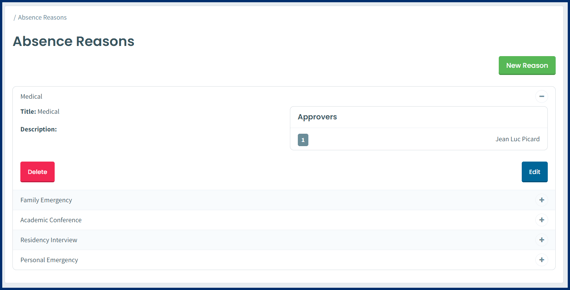
To add a reason, click on New Reason.
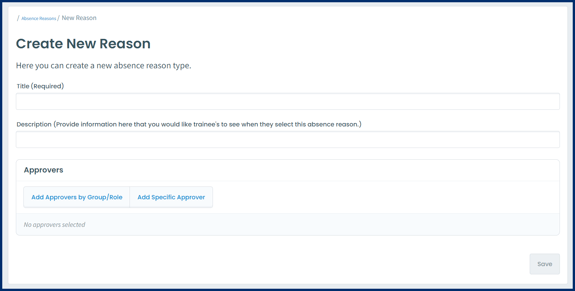
Provide a required title and optionally provide a description. Learners will see this when they log an absence to help them make sure they select the correct reason for their absence.
-
You can add approvers based on group: role permissions in Elentra (e.g. staff: admin) or you can add individuals.
-
If you set a group: role to be the approver, when a learner requests an absence they will be required to select a specific person from a list of users. This list will represent those user types who are course contacts for the courses the learner is enrolled in.
-
If you do choose to set group: role as approvers, the following user types can be setup to approve absence requests: staff: admin, staff: pcoor, staff: staff, faculty: director, faculty: faculty, and faculty: lecturer.
-
-
If you add multiple approvers the person listed earlier on the list will need to approve the absence before it gets sent to the second approver.
-
Click Cancel beside a name or group: role to remove them as reviewers.
-
Click Save to complete your reason. You will return to the list of reasons and your newly created reason should display.
Pools
Finally, you will need to create absence pools. This is where you can configure timeframes and groups for tracking absences. For example, if absences are tracked by course, you could make pools for each course.
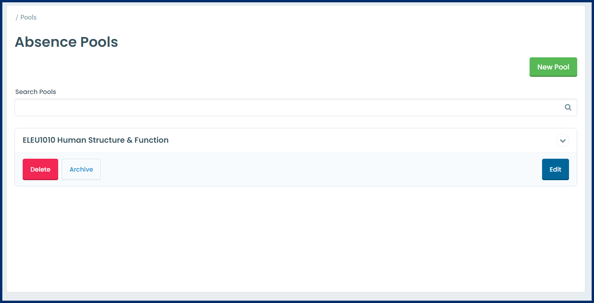 From the Pools dashboard, you can create a new pool and manage existing pools. Click on New Pool to begin.
From the Pools dashboard, you can create a new pool and manage existing pools. Click on New Pool to begin.
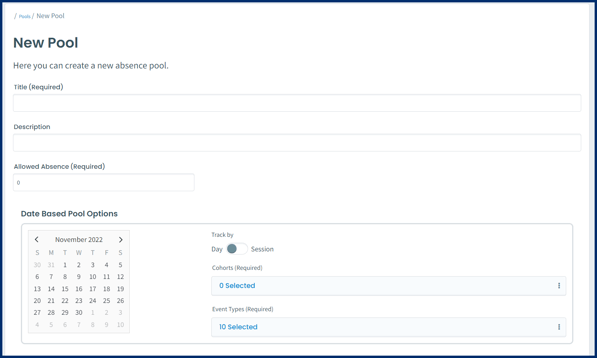 Provide a title, description, the total allowable absences, and set the date range & cohort. If you have enabled tracking absences by event you will also have the ability to associated specific event types with each pool.
Provide a title, description, the total allowable absences, and set the date range & cohort. If you have enabled tracking absences by event you will also have the ability to associated specific event types with each pool.
Absence Notifications
Note: The notifications mentioned below display in the Elentra ME Message Center. Users do not get sent emails about their absence requests.
Learners and approvers of absence reasons will receive notifications in the following circumstances:
- An absence request has been submitted and the user is set as the approver
- Note that if there are multiple approvers, the first approver must approve the request before a notification will be sent to the second approver. If the first approver rejects the request, no notification will be sent to the second approver.
- There has been a request for additional information on an absence request
- A learner has reached or exceeded the maximum absences allowed for a pool
